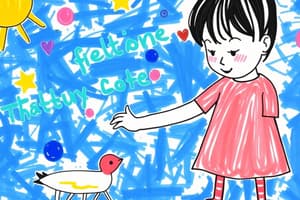Podcast
Questions and Answers
Graphic arts include only painting and drawing.
Graphic arts include only painting and drawing.
False (B)
Plastic arts involve the creation of three-dimensional forms.
Plastic arts involve the creation of three-dimensional forms.
True (A)
Art is described as an attitude of spirit and a state of mind.
Art is described as an attitude of spirit and a state of mind.
True (A)
Art must only be imitative to be considered art.
Art must only be imitative to be considered art.
Art appreciation can be developed through experience with art tools and materials.
Art appreciation can be developed through experience with art tools and materials.
Non-presentational art has a clear resemblance to real subjects.
Non-presentational art has a clear resemblance to real subjects.
Art is meant to benefit and satisfy man in practical terms.
Art is meant to benefit and satisfy man in practical terms.
Sculpture is included in the definition of plastic arts.
Sculpture is included in the definition of plastic arts.
Art appreciation solely involves owning works of art.
Art appreciation solely involves owning works of art.
Landscape architecture is classified under graphic arts.
Landscape architecture is classified under graphic arts.
Flashcards are hidden until you start studying
Study Notes
Graphic and Plastic Arts
- Graphic Arts: Involves painting, drawing, photography, printing (graphic processes), commercial art (designing books, advertisements, signs, posters, displays).
- Plastic Arts: Encompasses all visual arts organized into three-dimensional forms including architecture, landscape architecture (gardens, parks, etc.), city planning, interior design (wallpapers, furniture), sculpture, crafts, industrial design, costume design, and theater design.
The Importance of Art
- Art is a fundamental form of human expression, considered one of the oldest means of communication developed by mankind.
- John Dewey describes art as an attitude of spirit and state of mind, requiring fulfillment through the transformation of materials into meaningful forms.
- According to Panizo and Rustia, art is the composition of nature's qualities (e.g., colors, sounds, lines) to express human emotions and thoughts in an enjoyable manner.
Characteristics of Art
- Man-Made: Art must be created by humans.
- Creativity: It should be innovative and not merely imitative.
- Utility: Art should benefit and satisfy human needs, serving practical purposes.
- Medium of Expression: It is conveyed through specific materials or mediums enabling artists to communicate with their audience.
Art Appreciation
- Definition: The ability to interpret and understand man-made art; involves direct experience with art tools or enjoyment from possessing artworks.
- Types of Art:
- Representational/Objective Arts: Depicts recognizable subjects or forms.
- Non-Presentational Arts: Lacks resemblance to any real subject, often abstract.
Studying That Suits You
Use AI to generate personalized quizzes and flashcards to suit your learning preferences.




